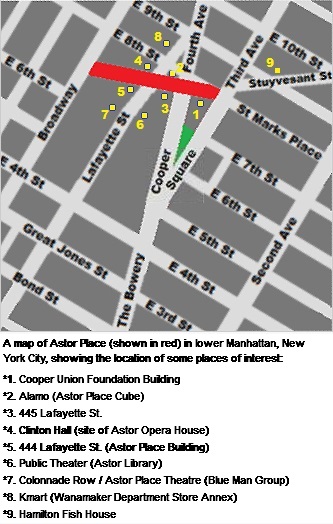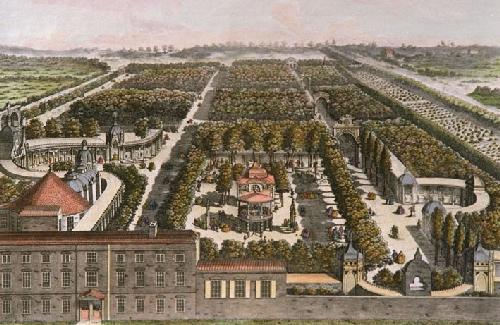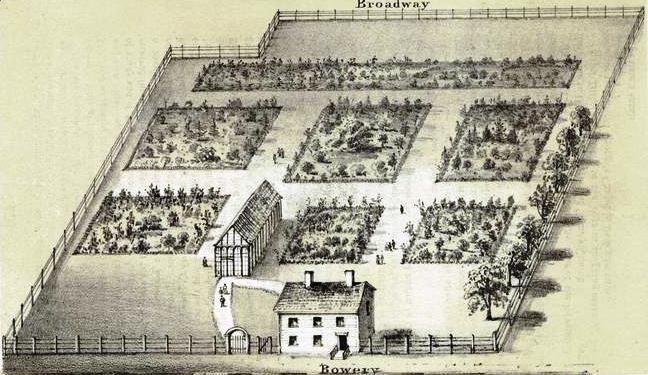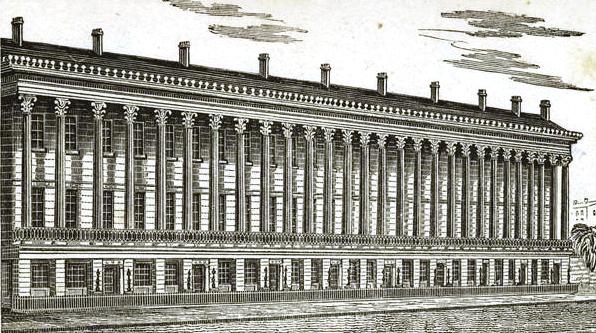|
Lafayette Street (Manhattan)
Lafayette Street is a major north-south street in New York City's Lower Manhattan. It originates at the intersection of Reade Street and Centre Street (Manhattan), Centre Street, one block north of Chambers Street (Manhattan), Chambers Street. The one-way street then successively runs through Chinatown, Manhattan, Chinatown, Little Italy, Manhattan, Little Italy, NoLIta, and NoHo, Manhattan, NoHo and finally, between 9th Street (Manhattan), East 9th and 10th Street (Manhattan), East 10th Streets, merges with Park Avenue, Fourth Avenue. A buffered bike lane runs outside the left traffic lane. North of Spring Street (Manhattan), Spring Street, Lafayette Street is northbound (Uptown Manhattan, uptown)-only; south of Spring Street, Lafayette is southbound (Downtown Manhattan, downtown)-only. The street is named after the Gilbert du Motier, Marquis de Lafayette, Marquis de Lafayette, a French hero of the American Revolutionary War. History Early years (1804-1887) The street origi ... [...More Info...] [...Related Items...] OR: [Wikipedia] [Google] [Baidu] |
Public Theater
The Public Theater is a New York City arts organization founded as the Shakespeare Workshop in 1954 by Joseph Papp, with the intention of showcasing the works of up-and-coming playwrights and performers.Epstein, Helen. ''Joe Papp: An American Life'', Da Capo Press, March 1, 1996. Led by JoAnne Akalaitis from 1991 to 1993 and by George C. Wolfe from 1993 to 2004, it is currently led by Artistic Director Oskar Eustis and Executive Director Patrick Willingham. The venue opened in 1967, with the world-premiere production of the musical ''Hair'' as its first show. The Public is headquartered at 425 Lafayette Street in the former Astor Library in Lower Manhattan. The building holds five theater spaces and Joe's Pub, a cabaret-style venue used for new work, musical performances, spoken-word artists, and soloists. The Public also operates the Delacorte Theater in Central Park, where it presents Shakespeare in the Park. New York natives and visitors alike have been enjoying free Shakesp ... [...More Info...] [...Related Items...] OR: [Wikipedia] [Google] [Baidu] |
Uptown Manhattan
Upper Manhattan is the most northern region of the New York City borough of Manhattan. Its southern boundary has been variously defined, but some of the most common usages are 96th Street, the northern boundary of Central Park (110th Street), 125th Street, or 155th Street. The term Uptown can refer to Upper Manhattan, but is often used more generally for neighborhoods above 59th Street; in the broader definition, Uptown encompasses Upper Manhattan. Upper Manhattan is generally taken to include the neighborhoods of Marble Hill, Inwood, Washington Heights (including Fort George, Sherman Creek and Hudson Heights), Harlem (including Sugar Hill, Hamilton Heights and Manhattanville), East Harlem, Morningside Heights, and Manhattan Valley (in the Upper West Side). The George Washington Bridge connects Washington Heights in Upper Manhattan across the Hudson River to Fort Lee, New Jersey, and is the world's busiest motor vehicle bridge. In the late 19th century, the IRT Nin ... [...More Info...] [...Related Items...] OR: [Wikipedia] [Google] [Baidu] |
Great Jones Street
__NOTOC__ Great Jones Street is a street in New York City's NoHo district in Manhattan, essentially another name for 3rd Street between Broadway and the Bowery. The street was named for Samuel Jones, a lawyer who became known as "The Father of The New York Bar" due to his work on revising New York State's statutes in 1789 along with Richard Varick, who had a street in SoHo named after him. Jones was a member of the New York State Assembly from 1796 to 1799, and he also served as the state's first Comptroller., p.56 Jones deeded the site of the street to the city with the stipulation that any street that ran through the property had to be named for him. However, when the street was first created in 1789, the city already had a Jones Street in Greenwich Village, named for Dr. Gardner Jones, Samuel Jones's brother-in-law.Boland, Ed, Jr"F.Y.I." ''New York Times'' (March 17, 2002). Accessed October 8, 2007. "In 1789 a street was opened there, but New York already had a Jone ... [...More Info...] [...Related Items...] OR: [Wikipedia] [Google] [Baidu] |
Astor Place
Astor Place is a one-block street in NoHo/ East Village, in the lower part of the New York City borough of Manhattan. It runs from Broadway in the west (just below East 8th Street) to Lafayette Street. The street encompasses two plazas at the intersection with Cooper Square, Lafayette Street, Fourth Avenue, and Eighth Street – Alamo Plaza and Astor Place Station Plaza. "Astor Place" is also sometimes used for the neighborhood around the street.Elsroad, Linda. "Astor Place" in p.64 It was named for John Jacob Astor (at one time the richest person in the United States), soon after his death in 1848. A $21 million reconstruction to implement a redesign of Astor Place began in 2013 and was completed in 2016. Geography The ''American Guide Series'' describes the Astor Place district as running from Houston Street north to 14th Street, between Broadway and Third Avenue. ''The Encyclopedia of New York City'' defines the neighborhood as between 4th Street and 8th Street, from Br ... [...More Info...] [...Related Items...] OR: [Wikipedia] [Google] [Baidu] |
Vauxhall Gardens
Vauxhall Gardens is a public park in Kennington in the London Borough of Lambeth, England, on the south bank of the River Thames. Originally known as New Spring Gardens, it is believed to have opened before the Restoration of 1660, being mentioned by Samuel Pepys in 1662. From 1785 to 1859, the site was known as Vauxhall, a pleasure garden and one of the leading venues for public entertainment in London from the mid-17th century to the mid-19th century. The Gardens consisted of several acres of trees and shrubs with attractive walks. Initially entrance was free, with food and drink being sold to support the venture. It was accessed by boat until the erection of Vauxhall Bridge in the 1810s. The area was absorbed into the metropolis as the city expanded in the early to mid-19th century. The site became Vauxhall Gardens in 1785 and admission was charged for its attractions. The Gardens drew enormous crowds, with its paths being noted for romantic assignations. Tightrope wal ... [...More Info...] [...Related Items...] OR: [Wikipedia] [Google] [Baidu] |
New York Vauxhall Gardens
The Vauxhall Gardens (in New York City), was a pleasure garden and theater. It was named for the Vauxhall Gardens of London.Ogasapian, John (2004). ''American History through Music: Music of the Colonial and Revolutionary Era''. Westport, Connecticut: Greenwood Press. . Though the venue passed through a long list of owners, and suffered buyouts, closings, relocations, and re-openings, it lasted until the mid-19th century.Caldwell, Mark (2005). ''New York Night: The Mystique and Its History''. New York City: Scribner. . History Vauxhall Gardens, Greenwich Street In the mid-1760s, out-of-town taverns, such as John Clapp's in the Bowery, had become popular in Colonial New York, taking advantage of the " Sunset Strip-like" jurisdiction, two miles from the post office,. At a site called "Bowling Green" since 1722, Samuel Fraunces opened a pleasure garden, first called the '' Vaux-Hall Gardens'', in New York, in 1767 and it received a chief competitor in the much larger Ranelagh Garde ... [...More Info...] [...Related Items...] OR: [Wikipedia] [Google] [Baidu] |
John Jacob Astor
John Jacob Astor (born Johann Jakob Astor; July 17, 1763 – March 29, 1848) was a German-American businessman, merchant, real estate mogul, and investor who made his fortune mainly in a fur trade monopoly, by smuggling opium into China, and by investing in real estate in or around New York City. He was the first prominent member of the Astor family and the first multi-millionaire in the United States. Born in Germany, Astor emigrated to England as a teenager and worked as a musical instrument manufacturer. He moved to the United States after the American Revolutionary War. Seeing the expansion of population to the west, he entered the fur trade and built a monopoly, managing a business empire that extended to the Great Lakes region and Canada, and later expanded into the American West and Pacific coast. Seeing a decline in demand due to changing European tastes, he got out of the fur trade in 1830, diversifying by investing in New York City real estate. Astor was highly wealt ... [...More Info...] [...Related Items...] OR: [Wikipedia] [Google] [Baidu] |
Downtown Community Television Center
The Downtown Community Television Center or DCTV is a community media center located in the former Engine Company 31 firehouse in Manhattan's Civic Center on Lafayette Street. It was founded in 1972 by spouses documentary film director Jon Alpert and Keiko Tsuno. Mission According to their website, DCTV "introduc smembers of the community to the basics of electronic media through hundreds of free or low-cost production courses and access to broadcast-quality production equipment." DCTV conducts classes enabling people from less privileged backgrounds to learn to create video productions and operates studios available to them for low cost. These programs are funded in part by earnings from DCTV's own documentary films which have won 16 national Emmy awards and many other honors. Facilities DCTV is based in Firehouse, Engine Company 31, a landmarked firehouse at 87 Lafayette Street in Manhattan, constructed in 1895 and purchased by DCTV in the 1980s. Programs Pro-TV (Profe ... [...More Info...] [...Related Items...] OR: [Wikipedia] [Google] [Baidu] |
Napoleon LeBrun
Napoleon Eugene Charles Henry LeBrun (January 2, 1821 – July 9, 1901) was an American architect. He began his career in Philadelphia designing churches and theatres including St. Augustine's Church, the Cathedral-Basilica of Sts. Peter and Paul and the Philadelphia Academy of Music. He moved to New York City, established the firm Napoleon LeBrun & Sons and designed multiple additional churches. He became the official architect of the Fire Department of New York and designed 42 firehouses between 1879 and 1895. He also designed early skyscrapers in New York City such as the Metropolitan Life Insurance Company Tower and the Home Life Building. Biography In Philadelphia LeBrun was born on January 2, 1821 in Philadelphia to Charles and Adelaide (Madelaine) LeBrun. Both parents were well-educated Catholics born in France. His father supported the family by working as an author, teacher and translator. LeBrun's early architectural training began at the age of 15 when he worked in th ... [...More Info...] [...Related Items...] OR: [Wikipedia] [Google] [Baidu] |
Henry Janeway Hardenbergh
Henry Janeway Hardenbergh (February 6, 1847 – March 13, 1918) was an American architect, best known for his hotels and apartment buildings, and as a "master of a new building form — the skyscraper." Life and career Hardenbergh was born in New Brunswick, New Jersey, of a Dutch family, and attended the Hasbrouck Institute in Jersey City. He apprenticed in New York from 1865 to 1870 under Detlef Lienau, and, in 1870, opened his own practice there.Pierson, Majorie (ed.) et al"Ladies' Mile Historic District Designation Report v.2" New York City Landmarks Preservation Commission (May 2, 1989) He obtained his first contracts for three buildings at Rutgers College in New Brunswick, New Jersey—the expansion of Alexander Johnston Hall (1871), designing and building Geology Hall (1872) and the Kirkpatrick Chapel (1873)—through family connections. Hardenbergh's great-great grandfather, the Reverend Jacob Rutsen Hardenbergh, had been the first president of Rutgers College from 178 ... [...More Info...] [...Related Items...] OR: [Wikipedia] [Google] [Baidu] |
Romanesque Revival
Romanesque Revival (or Neo-Romanesque) is a style of building employed beginning in the mid-19th century inspired by the 11th- and 12th-century Romanesque architecture. Unlike the historic Romanesque style, Romanesque Revival buildings tended to feature more simplified arches and windows than their historic counterparts. An early variety of Romanesque Revival style known as Rundbogenstil ("Round-arched style") was popular in German lands and in the German diaspora beginning in the 1830s. By far the most prominent and influential American architect working in a free "Romanesque" manner was Henry Hobson Richardson. In the United States, the style derived from examples set by him are termed Richardsonian Romanesque, of which not all are Romanesque Revival. Romanesque Revival is also sometimes referred to as the " Norman style" or " Lombard style", particularly in works published during the 19th century after variations of historic Romanesque that were developed by the Normans in Eng ... [...More Info...] [...Related Items...] OR: [Wikipedia] [Google] [Baidu] |
Colonnade Row
Colonnade Row, also known as LaGrange Terrace, on present-day Lafayette Street in New York City's NoHo neighborhood, is a landmarked series of Greek revival buildings originally built in the early 1830s. They are believed to have been built by Seth Geer, although the project has been attributed to a number of other architects. The buildings' original name comes from the Marquis de Lafayette's estate in France, but the series of nine row houses, of which four remain, owe their existence to John Jacob Astor, who bought the property and whose grandson John Jacob Astor III later lived at No. 424. The buildings are listed on the National Register of Historic Places under the name LaGrange Terrace and the facades remain standing on Lafayette Street south of Astor Place. Design The nine original buildings, a series of Greek revival townhouses built by Seth Geer, a contractor from Albany, New York (whose name is also given as "Greer") were located at 418–426 Lafayette Place o ... [...More Info...] [...Related Items...] OR: [Wikipedia] [Google] [Baidu] |





.jpg)
.jpg)
